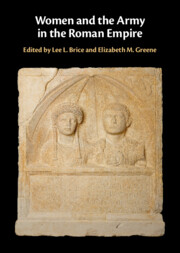Book contents
- Women and the Army in the Roman Empire
- Women and the Army in the Roman Empire
- Copyright page
- Dedication
- Contents
- Figures
- Maps
- Tables
- Contributors
- Acknowledgments
- Abbreviations
- Maps
- 1 Present but not Accounted For
- 2 Approaches to Women and the Roman Army
- 3 Agrippina and Company
- 4 Elite Marriage and Adultery in the Camp
- 5 Mother Courage and Her Children
- 6 Investigating Roles for Women inside Roman Military Bases through Artifact Distribution
- 7 (In)Visible Women and Children
- 8 Soldiers’ Wives en Route in Roman Egypt
- 9 The Role of Women in the Religious Activities of Roman Military Communities
- 10 Mater Castrorum
- 11 Women and the Military in the Age of Justinian
- Index
- References
8 - Soldiers’ Wives en Route in Roman Egypt
A Study through Graffiti, Private Letters, and Official Documents
Published online by Cambridge University Press: 24 October 2024
- Women and the Army in the Roman Empire
- Women and the Army in the Roman Empire
- Copyright page
- Dedication
- Contents
- Figures
- Maps
- Tables
- Contributors
- Acknowledgments
- Abbreviations
- Maps
- 1 Present but not Accounted For
- 2 Approaches to Women and the Roman Army
- 3 Agrippina and Company
- 4 Elite Marriage and Adultery in the Camp
- 5 Mother Courage and Her Children
- 6 Investigating Roles for Women inside Roman Military Bases through Artifact Distribution
- 7 (In)Visible Women and Children
- 8 Soldiers’ Wives en Route in Roman Egypt
- 9 The Role of Women in the Religious Activities of Roman Military Communities
- 10 Mater Castrorum
- 11 Women and the Military in the Age of Justinian
- Index
- References
Summary
A substantial collection of sources indicates that women constituted a considerable part of the travelers in the first centuries of the Roman Empire, a period in which traveling became increasingly popular with various social classes. These travelers have left traces of their experiences en route in personal letters on papyri and ostraca, in graffiti and on votive inscriptions. Classical scholarship has long ignored these sources, even though they offer us a unique insight into female experiences and self-representation. Recent excavations on and near the trade routes in the Eastern and Western Desert of Egypt, along which units of the Roman army were positioned in military outposts, protecting and controlling the area, have uncovered letters in which women – most of them of lower rank – discussed their concerns about traveling from and to the military camps of their husbands, fathers, or brothers. When combined with other sources such as papyri and graffiti, these documents give insight into the mobility of the female relatives of soldiers in Roman Egypt. They tell us something about the reasons why they decided to undertake journeys, the distance they covered (some while being heavily pregnant), where they stayed, and the dangers they encountered during the trip.
- Type
- Chapter
- Information
- Women and the Army in the Roman Empire , pp. 219 - 239Publisher: Cambridge University PressPrint publication year: 2024

